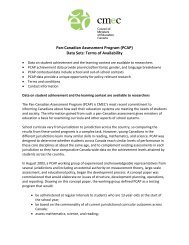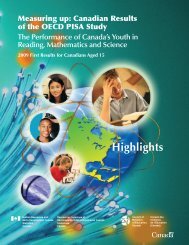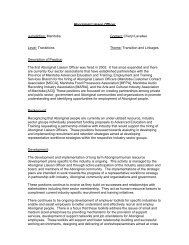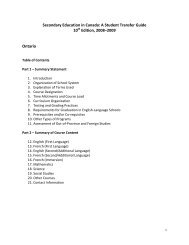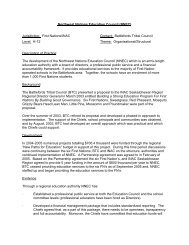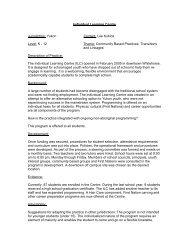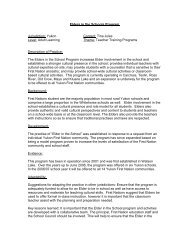highlights - Conseil des ministres de l'Ãducation du Canada (CMEC)
highlights - Conseil des ministres de l'Ãducation du Canada (CMEC)
highlights - Conseil des ministres de l'Ãducation du Canada (CMEC)
Create successful ePaper yourself
Turn your PDF publications into a flip-book with our unique Google optimized e-Paper software.
itish columbia• To enhance stu<strong>de</strong>nts’ learning experience and thus stu<strong>de</strong>ntretention, iBook computers were distributed to 60 stu<strong>de</strong>nts and300 staff members in 2005–06 and to more than 2,000 stu<strong>de</strong>ntsand 300 staff members in 2008–09. During the same time period,90 per cent of all CSF teachers used computers in their classroom.A cyber pédagogue [computer specialist] team was created andtrained; it i<strong>de</strong>ntified teaching strategies that would better supportstu<strong>de</strong>nt achievement, foster stu<strong>de</strong>nts’ <strong>de</strong>velopment of culturali<strong>de</strong>ntity and a sense of belonging to their francophone community,and facilitate the implementation of new learning technologies tobetter respond to stu<strong>de</strong>nts’ needs.• Simon Fraser University <strong>de</strong>veloped and <strong>de</strong>livered French-languagee<strong>du</strong>cation courses for a new minor-in-French program; offeredthe gra<strong>du</strong>ate diploma program in French e<strong>du</strong>cation; and <strong>de</strong>liveredthe gra<strong>du</strong>ate master’s program and the French-language doctoralprogram in e<strong>du</strong>cational lea<strong>de</strong>rship.HIGHLIGHTS OF ACHIEVEMENTS INSECOND-LANGUAGE INSTRUCTIONBritish Columbia’s achievements in second-language instruction,between 2005–06 and 2008–09, inclu<strong>de</strong>d the following outcomessupported by fe<strong>de</strong>ral–provincial funding arrangements:• Fifty-seven school districts were able to enhance and expan<strong>de</strong>xisting core French programs.• School districts offered their stu<strong>de</strong>nts access to quality Frenchimmersion programs: 254 public schools offered French immersionprograms to 42,474 stu<strong>de</strong>nts; four in<strong>de</strong>pen<strong>de</strong>nt schools offeredFrench immersion programs to 513 stu<strong>de</strong>nts. In 2008–09,42,474 stu<strong>de</strong>nts were enrolled in French immersion programsin the public schools, representing an unprece<strong>de</strong>nted highof 6.5 per cent of the province’s total stu<strong>de</strong>nt population.• Core French and French immersion teachers had the opportunityto upgra<strong>de</strong> their teaching and linguistic skills: 130 teachersrequested bursaries in 2005–06; 147 requested them in 2006–07;154 in 2007–08; and 159 in 2008–09. Some teachers took a varietyof courses including intensive French immersion programs whileothers pursued master’s <strong>de</strong>grees. Collège É<strong>du</strong>cacentre <strong>de</strong>veloped andoffered French-for-teachers workshops to 125 core French teachersfrom four districts.14Pan-Canadian Report on Official Languages in E<strong>du</strong>cation 2005–06 to 2008–09 HIGHLIGHTS




